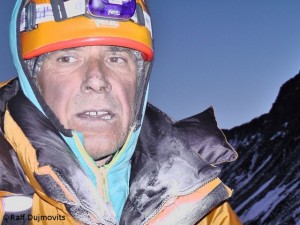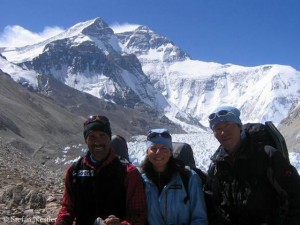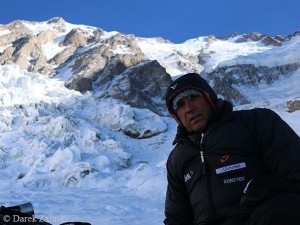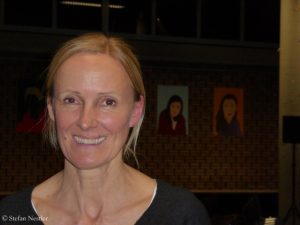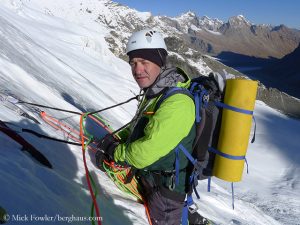Ralf Dujmovits: Mount Everest, take six!
How could the Portuguese explorer Fernando Magellan see so many campfires at the southern tip of South America in 1520 that he named the region “Tierra del Fuego”? Actually, the typical constant rain there should have extinguished any flame. During their expedition to Monte Sarmiento in Tierra del Fuego Gerlinde Kaltenbrunner, Ralf Dujmovits, Ralf Gantzhorn and Rainer Pircher had only two half days without rain. Furthermore wind speeds up to 150 kilometers per hour at a height of 1800 meters. Thus the plan failed to climb the main summit of the 2246-meter-high, pyramid-shaped mountain via the North Face. In addition to bad weather the team had bad luck. A snow cave at 1600 meters, where the climbers had deposited their gear during their first attempt, had disappeared, when they climbed up for the second time.
No problem with excess baggage
“We had marked the cave by GPS data and an avalanche probe that was showing two meters above the snow. But probably the snow cave collapsed due to very the warm weather and heavy rains and slipped off with the whole slope”, Ralf told me after returning home to Germany. “The only advantage we had by loosing all our equipment was that we hadn’t any problem with excess baggage.” The 52-year-old mountaineer was staying at home only for a short stopover. Late on Monday he flew to Nepal and afterwards will travel on to Tibet. Again, Dujmovits will try to reach the summit of Mount Everest without bottled oxygen. The highest of all mountains is the only one of the 14 eight-thousanders, which (in 1992) he has climbed with a breathing mask.
“Definitely my last attempt”
Ralf , two years ago you said: “For all time, I will make no more ascent of Mount Everest without supplemental oxygen and without Sherpa support. I have promised Gerlinde.” Why did you change your mind?
You know, never say never! I have made this mistake in 2012. Last fall, I was very well prepared to climb Mount Everest, when my Australian colleague (Andrew Lock) finally cancelled the project. But I realized that I was still able to train hard to be in top form. I wanted to use it for my winter attempt on Nanga Parbat, but even that didn’t work. However, I’ve noticed that I can still achieve the necessary physical fitness. That’s why I am going to Mount Everest again. Even if you are older than 50, you should take a chance like this.
Do you still feel that you must make amends for having climbed Everest with bottled oxygen?
In a certain way, yes. I am still itching to do it. I would like to be successful. But this is definitely (he laughs) my last attempt without oxygen. Afterwards I will close the chapter Everest, no matter how my attempt will end. Now I’m going to climb on Everest for the sixth time, and I hope that I will succeed. I will do my best, let’s wait and see.
You have already failed to reach the summit of Everest without oxygen three times, twice on the north side. Once again you want to climb up on the Tibetan side of the mountain. Why?
I will not take again the route that I have tried twice with Gerlinde, the combination of Japanese Couloir and the Hornbein Couloir (“Supercouloir”) in the North Face (in 2005 and 2010). I would like to climb further to the left of the wall. First I will take the normal route up to the North Col, then I want to cross over to the Norton Couloir. This couloir has a slanting end, where already Reinhold Messner climbed during his solo ascent in 1980. However, this was in fall. In 2010, I saw that even in early summer there were much better conditions compared to the Supercouloir. I want to see whether it is like that again. If everything fits together, I would like to take this route.
And if it doesn’t fit, would the normal route be an alternative for you?
I think it depends very much on the conditions, on how I feel, how I have acclimatized. I really want to leave open all options. I don’t want to commit myself by now. With over 50, I’m well along in years. I have to explore my opportunities. And I can do this only on the mountain.
There will definitely be many climbers on Everest. Will this not be a problem for you, climbing without oxygen?
That’s the advantage of this other route, where no one else will climb. If you are on the normal route – whether on the Nepalese or the Tibetan side – you run the risk of getting stuck in traffic jams with the climbers who are using bottled oxygen. In that case, due to the deep cold, you will have no chance climbing without oxygen. The low oxygen partial pressure is not the only problem up there. By breathing rapidly, the body heat is lost. And if you do it for a long time at high altitude, you really have a high risk of frostbite. I would like to exclude that by climbing a route where I can walk at my own pace.
In our last conversation you told me that you wanted to act completely independently up on Everest. Also on Nanga Parbat you wanted to try a solo. Do you meanwhile feel better climbing alone at the highest mountains?
Let me put it this way: I know that I must have the chance to climb at my own pace. That means that I don’t want to be part of a rope team. I’ve become slower, I know that, and I have realized it on Everest in 2012 too. But if I can climb at my own pace – I really walk for many hours at a very steady pace without stopping – I get ahead very well. I also listen very carefully to the messages sent by my body. I really feel it as a relief when I can do it this way. Before, I felt better and safer when I was climbing in a rope team. But in the end it is only a false sense of security. And having got older, I have no more problems with loneliness.
There is a narrow ridge between fighting it out and being dogged. Do you put yourself under pressure?
Stefan, I’ll do it as relaxed as always before. I will certainly do my best to implement my plan. But I have turned around so often, and I would do it again. The most important thing, that I have, is my health, all my toes and fingers. I love climbing and I want to continue to be able to do so. I wouldn’t gamble with it. I’ll try to do my best, but first of all I want to come down healthy.
As you mentioned, you have been on Mount Everest five times since 1992. Now it’s your sixth attempt. Have you developed something like a personal relationship to this mountain? Has it grown close to your heart?
Of course! It has grown even very strong to my heart. Although it is Everest, about which you have heard so many bad and negative things. But I was often there in total silence and loneliness, with Gerlinde too. In 2012, I climbed to the South Col almost quite alone, ahead of the great masses. You can find your peace even there, and so you can live some way this relationship to the mountain. For me, this relationship to Everest has to do with the incredible height that allows unimaginable panoramic views. It’s amazing climbing up there. I love it. And I can enjoy it because I’m free of all these constraints. Of course there have been all these setbacks, after my success in 1992 with oxygen. But this story is a part of my life that I consider important. And now I return to Everest once again, really with pleasure.




